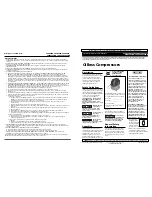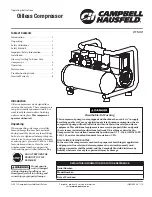
Section 1
SAFETY
1
1.1 GENERAL
Sullair Corporation and its subsidiaries design and
manufacture all of their products so they can be
operated safely. However, the responsibility for
safe operation rests with those who use and main-
tain these products. The following safety precau-
tions are offered as a guide which, if conscientious-
ly followed, will minimize the possibility of accidents
throughout the useful life of this equipment.
The compressor should be operated only by those
who have been trained and delegated to do so, and
who have read and understood this Operator’s
Manual. Failure to follow the instructions, proce-
dures and safety precautions in this manual may
result in accidents and injuries.
NEVER
start the compressor unless it is safe to do
so.
DO NOT
attempt to operate the compressor
with a known unsafe condition. Tag the compressor
and render it inoperative by disconnecting and lock-
ing out all power at source or otherwise disabling its
prime mover so others who may not know of the
unsafe condition cannot attempt to operate it until
the condition is corrected.
Install, use and operate the compressor only in full
compliance with all pertinent OSHA regulations
and/or any applicable Federal, State, and Local
codes, standards and regulations.
DO NOT
modify the compressor and/or controls in
any way except with written factory approval.
While not specifically applicable to all types of com-
pressors with all types of prime movers, most of the
precautionary statements contained herein are
applicable to most compressors and the concepts
behind these statements are generally applicable to
all compressors.
1.2 PERSONAL PROTECTIVE EQUIPMENT
Prior to installing or operating the compressor, own-
ers, employers and users should become familiar
with, and comply with, all applicable OSHA regula-
tions and/or any applicable Federal, State and
Local codes, standards, and regulations relative to
personal protective equipment, such as eye and
face protective equipment, respiratory protective
equipment, equipment intended to protect the
extremities, protective clothing, protective shields
and barriers and electrical protective equipment, as
well as noise exposure administrative and/or engi-
neering controls and/or personal hearing protective
equipment.
1.3 PRESSURE RELEASE
A.
Install an appropriate flow-limiting valve between
the service air outlet and the shut-off (throttle)
valve, either at the compressor or at any other point
along the air line, when an air hose exceeding
13mm inside diameter is to be connected to the
shut-off (throttle) valve, to reduce pressure in case
of hose failure, per OSHA Standard 29 CFR
1926.302(b)(7) and/or any applicable Federal,
State and Local codes, standards and regulations.
B.
When the hose is to be used to supply a mani-
fold, install an additional appropriate flow-limiting
valve between the manifold and each air hose
exceeding13mm inside diameter that is to be con-
nected to the manifold to reduce pressure in case
of hose failure.
C.
Provide an appropriate flow-limiting valve at the
beginning of each additional 23m of hose in runs of
air hose exceeding13mm inside diameter to reduce
pressure in case of hose failure.
D.
Flow-limiting valves are listed by pipe size and
flow-rated. Select appropriate valves accordingly, in
accordance with their manufacturer’s recommen-
dations.
E. DO NOT
use air tools that are rated below the
maximum rating of the compressor. Select air tools,
air hoses, pipes, valves, filters and other fittings
accordingly.
DO NOT
exceed manufacturer’s rated
safe operating pressures for these items.
F.
Secure all hose connections by wire, chain or
other suitable retaining device to prevent tools or
hose ends from being accidentally disconnected
and expelled.
G.
Open fluid filler cap only when compressor is not
running and is not pressurized. Shut down the
compressor and bleed the sump (receiver) to zero
internal pressure before removing the cap.
H.
Vent all internal pressure prior to opening any
line, fitting, hose, valve, drain plug, connection or
other component, such as filters and line oilers, and
before attempting to refill optional air line anti-icer
systems with antifreeze compound.
I.
Keep personnel out of line with and away from the
discharge opening of hoses or tools or other points
OPERATOR IS REQUIRED TO READ ENTIRE
INSTRUCTION MANUAL
Summary of Contents for LS20T 1100 CFM
Page 18: ...Section 2 DESCRIPTION 12 Figure 2 3B Control System Diagram START...
Page 19: ...Section 2 DESCRIPTION 13 Figure 2 3C Control System Diagram MODULATION...
Page 20: ...Section 2 DESCRIPTION 14 Figure 2 3D Control System Diagram FULL LOAD...
Page 21: ...Section 2 DESCRIPTION 15 Figure 2 3E Control System Diagram UNLOAD...
Page 44: ...NOTES 38...
Page 104: ...Section 9 ILLUSTRATIONS AND PARTS LIST 98 02250146 367R00 9 19 CONTROL START SYSTEM...
Page 106: ...Section 9 ILLUSTRATIONS AND PARTS LIST 100 02250146 367R00 9 19 CONTROL START SYSTEM...
Page 108: ...Section 9 ILLUSTRATIONS AND PARTS LIST 102 02250138 633R00 9 20 CONTROL PANEL...
Page 110: ...Section 9 ILLUSTRATIONS AND PARTS LIST 104 02250139 119R01 9 21 ENCLOSURE...
Page 112: ...Section 9 ILLUSTRATIONS AND PARTS LIST 106 02250139 119R01 9 21 ENCLOSURE...
Page 114: ...Section 9 ILLUSTRATIONS AND PARTS LIST 108 9 22 DECAL GROUP...
Page 116: ...Section 9 ILLUSTRATIONS AND PARTS LIST 110 9 22 DECAL GROUP...
Page 118: ...Section 9 ILLUSTRATIONS AND PARTS LIST 112 9 22 DECAL GROUP...
Page 120: ...Section 9 ILLUSTRATIONS AND PARTS LIST 114 9 23 DECAL LOCATIONS OPEN AIR COOLED...
Page 122: ...Section 9 ILLUSTRATIONS AND PARTS LIST 116 9 24 DECAL LOCATIONS OPEN WATER COOLED...
Page 124: ...Section 9 ILLUSTRATIONS AND PARTS LIST 118 9 25 DECAL LOCATIONS REMOTE COOLER...
Page 126: ...Section 9 ILLUSTRATIONS AND PARTS LIST 120 9 26 DECAL LOCATIONS CONTROL BOX...
Page 128: ...Section 9 ILLUSTRATIONS AND PARTS LIST 122 9 27 ENCLOSURE DECALS...
Page 145: ...NOTES 139...








































